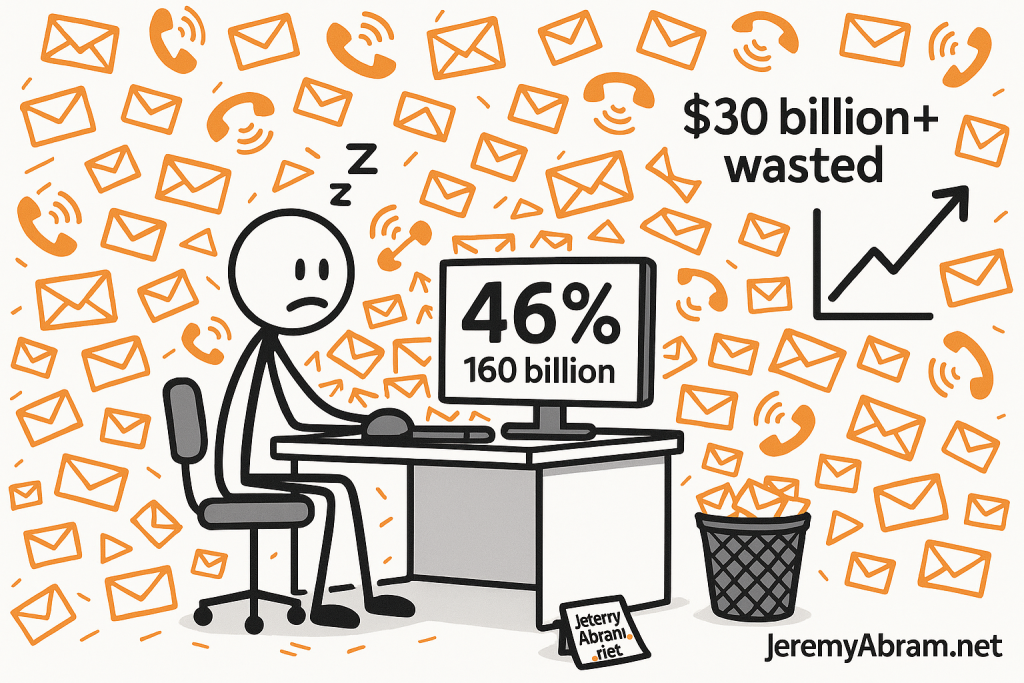SPAM BY THE NUMBERS

(Compiled November 2025 • © JeremyAbram.net)
Spam isn’t just annoying — it’s a measurable drain on time, money, and mental focus.
Here’s what the latest data says about how much of our lives it actually consumes.
EMAIL SPAM: A DAILY DELUGE
Every single day, roughly 160 billion spam emails are sent worldwide.
That’s nearly half of all global email traffic — about 46% of every inbox on Earth.
The average office worker now gets about 121 emails a day, spending almost a quarter of their work time (23%) inside their inbox.
Even a conservative estimate puts the global cost of spam-related productivity loss at over $20 billion a year.
For individual employees, that’s about two full workdays lost annually just deleting or sorting junk messages.
For a small ten-person business, that translates into nearly 70 workdays a year wasted on spam handling alone.
It’s not only about time. Around 69% of people say spam or phishing messages cause stress or mental fatigue,
and 57% have lost money through spam-related scams. Nearly three-quarters of identity theft incidents start from spam email.
Even if most spam is merely unwanted marketing, a small fraction — roughly 2.5% — carries real security risks like phishing or malware.
ROBOCALLS AND SPAM CALLS: A CONSTANT RING
Spam calling is just as relentless. The average American now receives around nine spam calls a month,
and collectively, U.S. consumers waste about 221 million hours per year answering or dismissing them.
In August 2023 alone, there were about 5.46 billion robocalls — roughly seventeen per person, every single day.
April 2025 saw nearly 5 billion robocalls nationwide, while January 2025 clocked 4.7 billion,
more than half of which were classified as scams or telemarketing.
About 31% of Americans say they get a scam call daily; 21% get several.
Nearly everyone — 92% of Americans — received a spam call last year,
and 86% were targeted by spam texts.
All told, an estimated 56 million Americans (about one in five adults) lost money to phone scams in 2023,
with total reported losses of $25 billion.
The average person spends roughly nine minutes each week screening or reacting to these calls —
which adds up to more than seven hours a year. It’s no wonder that almost half of all unidentified numbers now go unanswered.
THE TIME AND PRODUCTIVITY DRAIN
Between spam calls and spam emails, the typical individual loses about 7 to 15 hours every year —
not counting the extra time it takes to regain focus after each interruption.
For business users, the damage runs deeper: around 80 hours per employee per year.
In a small 10-person office, that adds up to 800 hours — or 100 workdays — lost annually.
Across the U.S. economy, spam costs translate into tens of billions of dollars in wasted productivity.
And because every interruption breaks concentration, psychologists say the real cost of “context-switching”
may double or even triple those time losses.
TRUST AND ATTENTION: THE HIDDEN COSTS
Spam doesn’t just waste time — it erodes trust.
Nearly seven in ten people say the constant flood of spam and scams raises anxiety levels.
Over half have experienced direct financial loss from spam or scam messages.
Almost half of all calls from unknown numbers now go unanswered.
That means legitimate businesses, recruiters, and service calls are often ignored
because people simply assume they’re fake.
This “trust tax” extends to email, too.
Even well-intentioned newsletters or offers get buried because users treat everything unfamiliar as potential spam.
The result: missed opportunities, delayed communication, and growing skepticism about digital contact itself.
THE BIG PICTURE
Zooming out, spam represents between 45 and 50% of all global email traffic.
Robocall volume in the United States now exceeds 50 billion calls each year.
Altogether, Americans lose more than 250 million hours annually to spam calls and spam emails combined.
At an average labor value of $25/hour, that’s over $6 billion in wasted time —
not counting an estimated $25 billion in fraud and scam losses.
In economic terms, the combined “spam tax” easily surpasses $30 billion a year.
And yet, the cost to send spam remains virtually zero.
Even with a success rate as low as one response per million messages (0.0001%),
spammers still make a profit.
As of 2025, the breakdown of spam content looks roughly like this:
- Phishing & fraud: 45%
- Marketing & advertising: 30%
- Adult or illicit content: 10%
- Malware or ransomware: 5%
- Miscellaneous other: 10%
DATA SOURCES
- Truecaller – U.S. Spam & Scam Report (2024-2025)
- Hiya – Global Phone Spam Report (H1 2024)
- YouMail Robocall Index (2025)
- Pew Research – “Online Scams in America Today” (2025)
- EmailToolTester – Global Spam Statistics 2024
- EFTSure – Spam Statistics and Fraud Trends (2024)
- AgainstData.com – Email Spam Costs Blog (2024)
- SQ Magazine – Spam Report (2025)
- CapstoneWorks – “The True Cost of Lost Spam”
- BlueRidge.Tech – “Hidden Costs of Spam Email” (2022)
- PIRG – “Ringing in Our Fears 2024”
- BusinessWire – Truecaller Scam Loss Report (2023)
- Comparitech – Phone Spam Case Study (2023)
- Wikipedia – CAN-SPAM Act Summary
- Arxiv (2410.17361) – Anti-Spoofing & Call Authentication Study
Summary:
Spam calls and spam emails are no longer small irritations — they’re measurable productivity killers and trust eroders.
They waste hundreds of millions of hours, cost billions in lost work and fraud, and degrade the integrity of digital communication itself.
Behind every unwanted ping, ding, or ring lies an invisible price tag — one we’re all paying, minute by minute.
===========================================
END OF POST
Leave a Reply